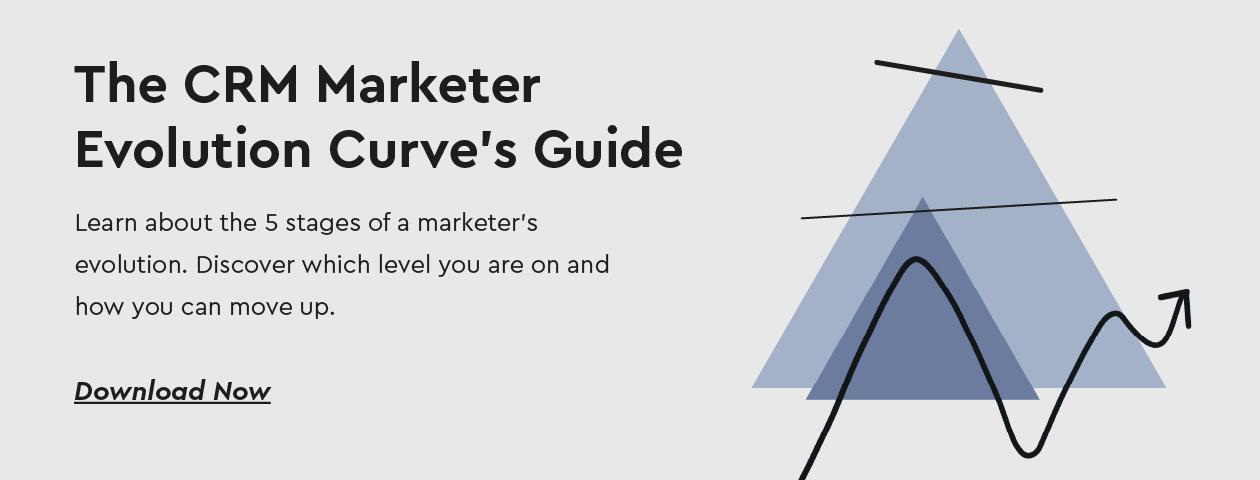What is a content recommendation engine?
A content recommendation engine is a platform that recommends personalized content to individual users based on their preferences and behaviors. This technology is commonly utilized on websites and applications to show content to visitors based on individual interests.
Many platforms show suggestions based on engagement. So, when you are new to a particular platform, you may not find any of the content suggestions to be useful. Optimove provides content recommendations based on your traffic source, so that we can begin to recommend products from your first visit.
Content recommendation engines can also feed dynamic content to the visitor. This content is based off of the customer’s past viewing behavior paired with viewing behavior from similar users, and the engine can generate content as you scroll down the page.
The CRM Marketer evolution curve
How does a content recommendation engine work?
A content recommendation engine works by combining data and machine learning technology. The most important aspect of this process is data: the more data there is, the more patterns are formed, making the process more relevant and efficient.
Collecting data: The first step is collecting as much data as possible. There are three main types of data to be collected.
- Implicit data – this includes engagement such as search history, clicks, and order history.
- Explicit data – this data is collected through customer input: reviews, likes/dislikes, comments, etc.
- Product catalog data – this refers to data associated with the products or items available in a system. This can include product descriptions, categories, genres, tags, prices, and other data related to the company’s items.
Storing data: The next step after collecting data is to store the data.
- This typically involves using a database or data storage system to securely execute the recommendation algorithm.
Content analysis: The next step is for the algorithm to look for patterns within the stored data. There are three main types of content analysis.
- Real-time analysis – This is when data is processed as it is generated, allowing for immediate recommendations.
- Batch analysis – This involves large volumes of data processed periodically, usually daily.
- Near-real time analysis – This type of analysis combines the two methods discussed above. Data is processed within minutes instead of seconds if you don’t need the data immediately.
Data filtering: There are three main types of data filtering to refine and select relevant data for the customer.
- Collaborative filtering – This type of filtering collects and analyzes a large variety of data to make predictions about a customer’s preferences.
- Content-based filtering – This type of engine recommends items to users based on attributes of the items themselves. The engine analyzes features such as genre, keywords, tags, or descriptions, and matches them with the user’s preferences.
- Hybrid recommendation – This model combines the collaborative and content-based models. Moreover, it produces more accurate recommendations than the individual methods alone.
Why are content recommendations important?
Content recommendations are important because they deliver personalized and engaging experiences to customers. This results in increased customer satisfaction and engagement, driving more conversions, increased basket size, and longer loyalty. When used beyond your website or app, content recommendations can drive traffic to these locations.
What are the benefits of content recommendation engines?
The benefits to content recommendation engines include:
- Enhancing sales and revenue: Recommendations can be leveraged to promote content or target advertisements to cross-sell specific products.
- Delivering a consistent brand experience: Content recommendations allow you to optimize the customer experience by combining all interactions with a website, so the customer doesn’t have to start fresh.
- Content exposure: Content recommendations expose users to content they may not have discovered otherwise.
- Personalizing customer experience: Content is tailored to the individual user.
- Promoting brand loyalty: Personalized recommendations can influence shoppers to buy the product they had their eye on and return to the site in the future.

What are some examples of content recommendation models?
- “Recommended for you”: This recommendation model shows content that is similar to items you have already purchased or viewed. For example, Amazon utilizes this model to suggest alternative options based on your previous buying behavior, encouraging you to discover related products.
- “Your Favorites”: This model suggests items or content based on a user’s preferences and engagement patterns. This is utilized by e-commerce websites to recommend content that matches customers frequently liked, listened to, or interacted with items.
- “New Product”: This suggesting recently released or newly available items that are likely to be of interest to customers based on their past interactions.
- “People also bought”: This model suggests items that are frequently purchased together with the item currently being viewed or purchased.
- “Most popular”: This model ranks items based on popularity or engagement metrics and presents items in an ordered list. This is seen in music streaming services like Spotify, so users can see the most popular songs or albums.
- “Trending now”: This recommendation model shows trending items among a particular user segment. It is often used by social media networks to highlight content that is currently popular or gaining attention. For example, the explore page on Instagram uses this model.
The CRM Marketer Evolution Curve’s Guide
Learn about the 5 stages of a marketer’s evolution. Discover which level you are on and how you can move up.
Learn How Optimove’s content recommendation engine solution Can Help You Grow Your Business
Optimove’s Digital Experience Platform (DXP) helps you deliver personalized, in-the-moment content recommendations on your website, app, and marketing channels, without guesswork or complexity. By using flexible testing to determine what works and what doesn’t, you can confidently provide exceptional, personalized experiences to your customers.
Our technology includes 20 sophisticated Machine Learning recommendation models to deliver immediate personalized content, including: Similar Items, Popular Near You, Trending, and Recently Purchased. This allows you to deliver personalized content recommendations from the first moment a visitor lands on your platform, during the session and after it finishes.
Frequently Asked Questions
What is an example of a content recommendation engine?
One of the most popular examples of a content recommendation engine is Netflix.
Netflix uses multiple filtering methods and machine learning algorithms to make recommendations to users. These recommendations suggest TV shows or movies based on user‘’s watch history or engagement with specific genres. This streaming service aims to provide personalized content that enhances customer experience and differentiates them from competitors.
What are the three types of machine learning models used by recommendation engines?
The three types of recommendation engines are collaborative filtering, content-based filtering, and hybrid filtering.
*Collaborative filtering: Makes individual recommendations based on similar users’ preferences and behavioral data.
*Content-based filtering: Matches features of specific items to certain user preferences.
*Hybrid filtering: Combines collaborative and content-based filtering for improved recommendations.

Contact us today – or request a Web demo – to learn how you can use Optimove’s Content Recommendation technology to leverage individual user experience and enhance data collection.
Get a personalized tour of Optimove
Let us show you how to go from tens to hundreds of segments


